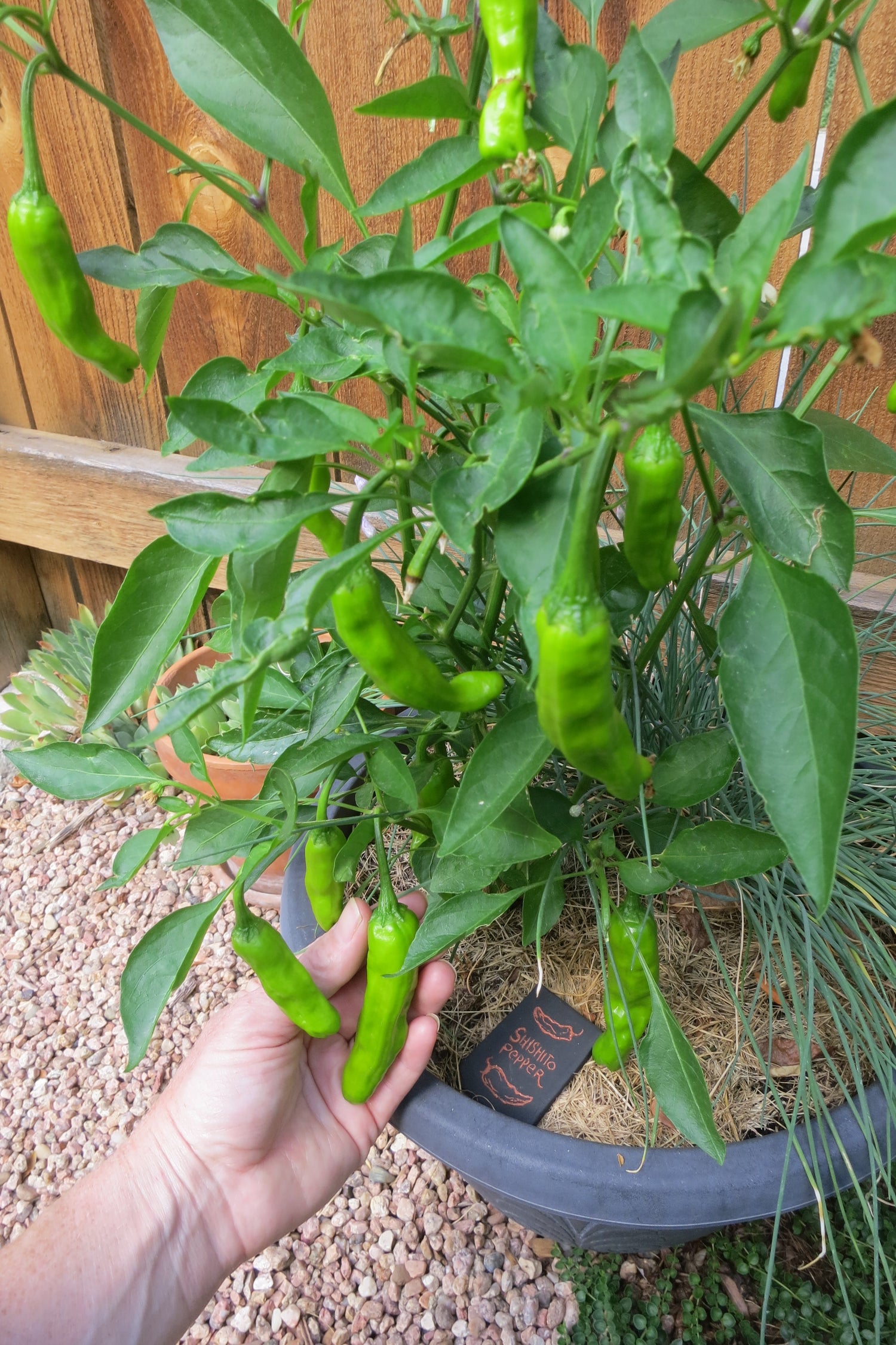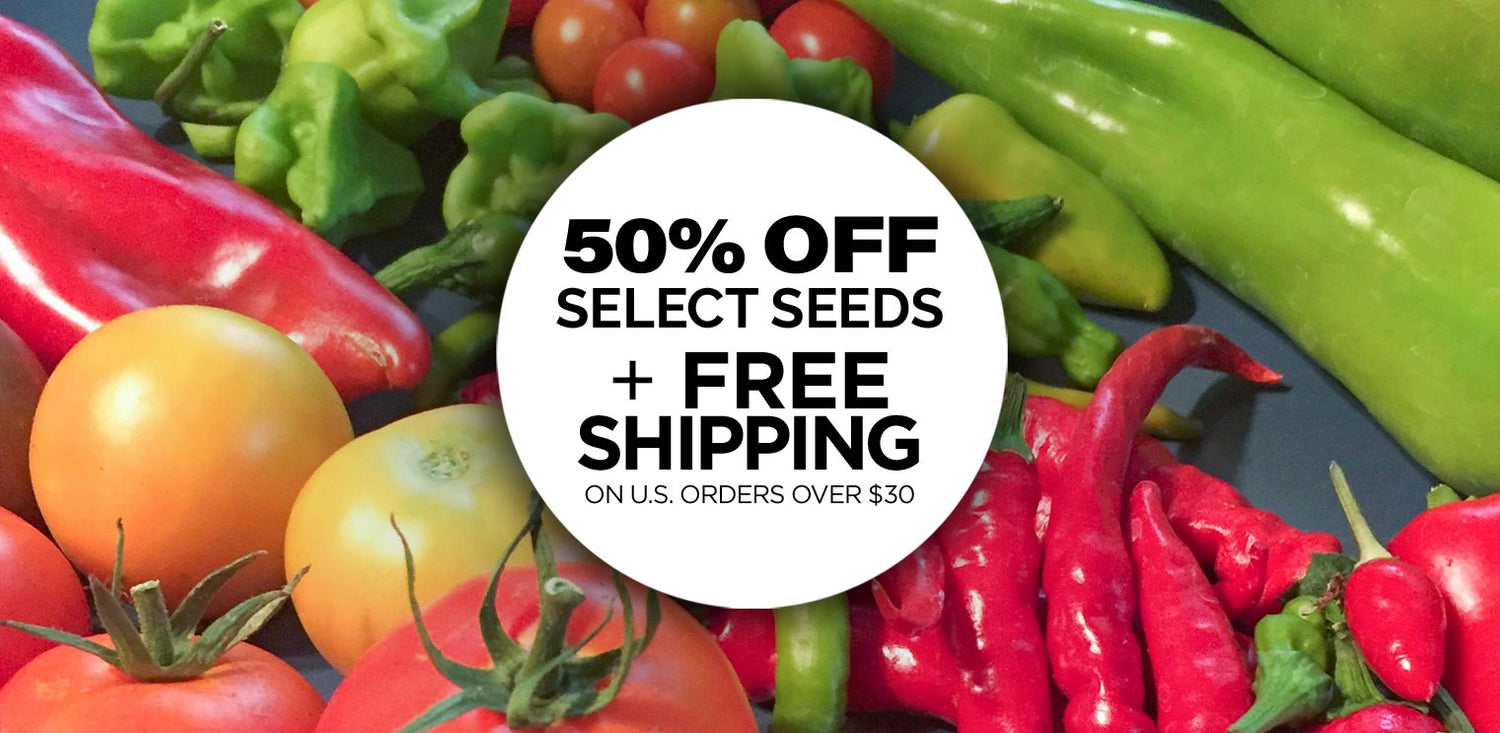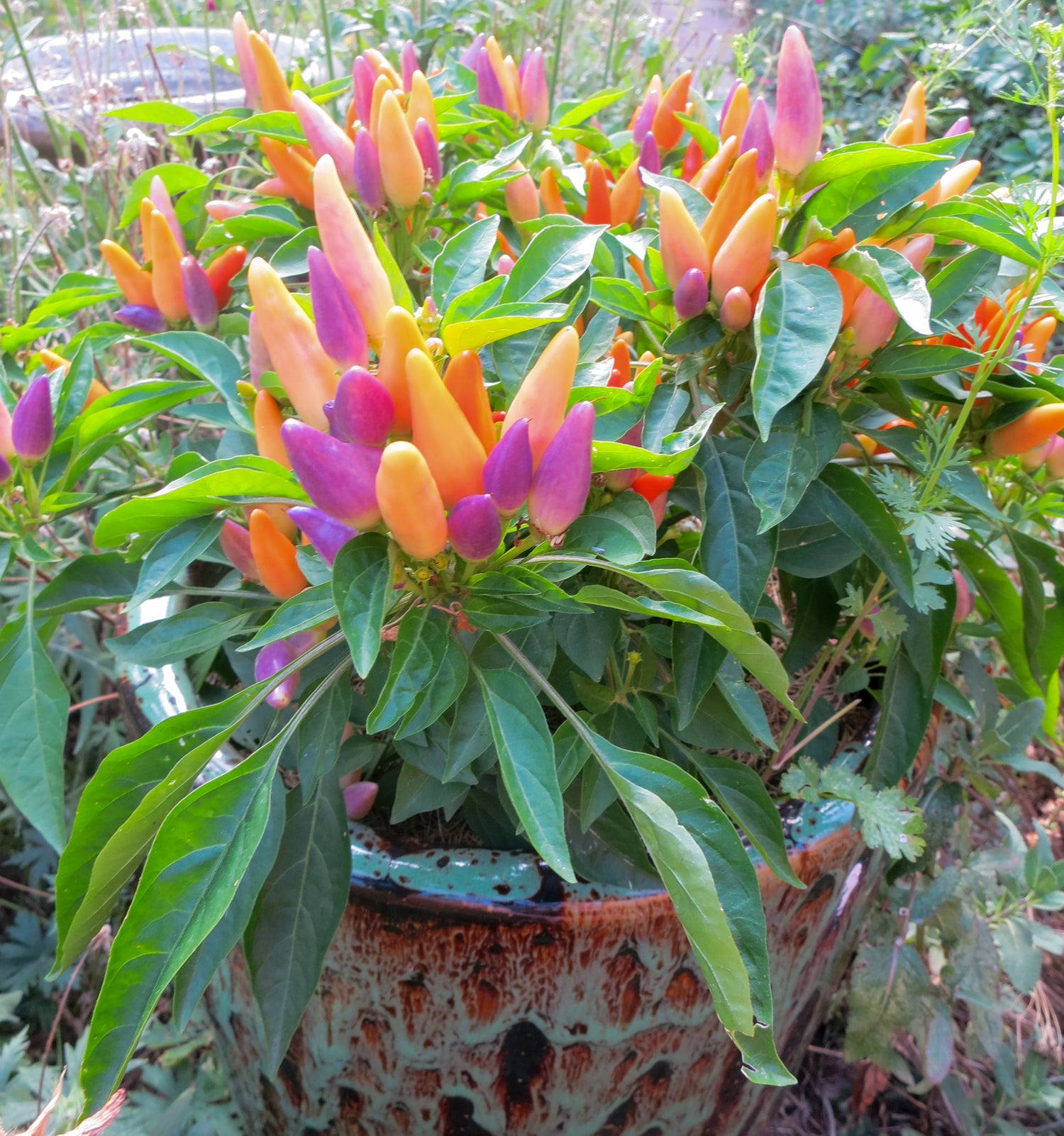There are many different growing zones in Colorado, and you can grow peppers in most areas that you can grow tomatoes and other veggies! For Colorado gardeners, starting peppers indoors is a must with short season gardening, we recommend starting your pepper seeds at least 6-8 weeks before mid-to-late May when you will transplant them into the garden. Use a seedling heat mat to keep the pepper seeds warm during germination, they like to germinate around 80˚F!
Choose
short season peppers for best results, as they can mature and produce lots of pods much more quickly so you get plenty before the first frost in autumn. Peppers grown from seed can do better than nursery-grown plants as you can plant them when they are younger so they don't get root bound and have a better chance of success. Plus, you can grow the varieties you want and experiment with new ones every season!
Grow Peppers in Pots in Colorado:
Growing peppers in pots allows you to extend the season as you can move them to sheltered locations during cold spells in spring or fall. Because pots and containers are filled with potting soil, peppers can grow and thrive more quickly, too, due to good drainage and loamy soil that is easy for roots to grow into. Colorado's soils are usually somewhat compacted and heavy with clay, so while peppers can be grown in the ground, it's good to add lots of homemade compost and make sure the soil is draining well and well aerated. Find the
Best Peppers for Containers »
 Growing Peppers in Denver – a Testimonial from one of our gardeners:
Growing Peppers in Denver – a Testimonial from one of our gardeners:
I love growing tomatoes and peppers to make sauces, salsa and hot sauces. I grow a variety of Sandia Seed's peppers and tomatoes every year, I try a few new ones each season and have some favorites that I listed below.
I have to say that like tomatoes, peppers are picky and are not always super easy to grow here in Denver's hot, dry, short-season climate. We deal with late snow/frosts and hailstorms in spring, super hot and dry summers, then early frosts in autumn. To be honest, every year for me most of my pepper plants do well, but a few plants will sometimes dwindle. I have yet to figure out why, it's probably something in the soil in the spot where a Shishito did great compared to another spot that it didn't hardly grow at all. So, I just keep planting several different varieties, and a few plants of each variety, and plant them in different places which helps me to have good success with most of the plants.
Starting peppers from seed seems to be more successful for me than buying plants at our local nurseries, I suspect because the nursery-grown plants are often root bound – they look bigger and better at the beginning of the season, but typically in the long run my smaller indoor-started peppers seedlings catch up and outpace the store-bought plants. Likely because my homegrown seedlings are younger and smaller, so their root systems grow better when transplanted into the garden or pots for the season.

I start my pepper seeds in two old Aerogardens using their styrofoam seed starting trays. It works great as I can grow 50 different plants in a very small space. Also, because Aerogardens use a water reservoir, I don't have to worry about the seedlings drying out, I can just add water once every week or two as needed. Also, without soil, the fungus gnats are not really a problem at all. One minor downside is that you do need to transplant them out of the seed starter tray after they get their first couple sets of leaves, as they can get root bound in the small holes designed for the growing sponges. Another downside is that you also have to buy the sponges, I've been using Park Seed's 60-cell sized sponges which also fit and are much less expensive if you buy them on sale and in bulk.
But overall, starting all my pepper and tomato seedlings in the Aerogarden is very successful! They germinate quickly and are very healthy, I can harden them off in the tray and transplant them directly into the garden, or sometimes I transplant some of them into their own 4-6" deep seedling pots and put them in my garden bed hoop house to grow bigger if I start them early. I typically start my pepper seeds in late March or early April, and then start the tomatoes a couple weeks later (late April) as tomatoes germinate and outgrow their space much more quickly than peppers do. Whatever you do, don't let them get root bound, make sure to plant them up into larger pots so their roots are not hindered from growth.

Above are some transplanted peppers in spring, staying warm in the garden bed hoop house until the cold nights and hailstorms are mostly past.

Peppers actually do best for me in large, 14”-16”+ wide/deep pots, probably because they have better drainage with good potting soil that is warmer than the ground. Having them in pots is also helpful as I can move and tuck them into my garden beed hoop house and keep them protected from spring cold-spells and and again in the fall to squeeze in a few more weeks after the first frost.

The greenhouse film traps the solar heat in and they survive even though it dips below freezing at night. However, this season extending is limited – if it gets down to the 20s though for too long, the pepper plants will be done for, but I've kept them alive and ripening peppers all the way through mid-November the past two years this way, no added heat needed. I think this weekend may be the last one if we get rain and the temperatures go way down.

The hoop house is also great for hail-protection, if a bad storm is predicted or just arrives, I will run out and move my pepper pots into the hoop house under hail netting to protect them. Works great! I bought the hail netting from a greenhouse supply website online, it was hard to find locally.
Of course, I’m hardcore about gardening, so I am not sure everyone would want to water and lug pots around every summer just for some peppers. haha! I am a chilehead, no question. I would do it with my tomatoes too if they weren’t so large! Maybe I should grow some of your dwarf tomatoes in a moveable pot so that I can squeeze them into the hoop house next year. ha!
 Jalapeno Jaloro, shown above
Jalapeno Jaloro, shown aboveI also find that my peppers that get partial shade actually seem to prefer it! We have a lot of trees around our home in Park Hill so a couple of my most productive peppers like Shishitos, for example, have about 6 hours of sunlight in the morning to mid-afternoon, then are shaded for the rest of the day by the apple tree. Perhaps because it's so hot and dry here they like a little shade.

So here are the peppers that do the best for me in Denver, CO:
Sweet Peppers:
Shishitos (in pots - very productive & earliest for me every year!)
Mild-Medium Heat Peppers:
(they have mild - hot, but I usually grow mild or medium so they don’t burn my hands when peeling the roasted chile’s skin and removing seeds)
Hot Peppers:
CascabellasVery productive plants with tons of small hot yellow peppers, good for pickling. They turn orange to red if left to ripen on the plant. I started growing these as I read in your blog that Mezzetta's pickled Hot peppers were made from them, so now I can make my own organic version!
Jamaican Hot Yellow Peppers (this year) - productive and seem to be faster growing than Habaneros (my favorite) and they are great for hot sauce and salsas
Fish Peppers - these mottled plants with striped peppers are hot and prolific!
Goat Horn Peppers - hot cayenne-like pods, great for salsas and hot sauce

Super Hot Peppers:
I don't find that super hots do that well here, as we just don't have enough time to grow them in one summer. HOWEVER! I did grow a
Habanero plant from seed very early in January in my Aerogarden, and the previous year I cloned one from the previous season and had it growing in the Aerogarden – they both grew quite well inside in the water - the root mass was huge! They even produced peppers inside, though they were quite small in size. I transplanted them outside into large pots in June, they dropped some leaves at first, but recovered quickly and produced the most Habaneros I've had because the plants were so much bigger with large root systems. So to grow super hots like Habaneros or
Carolina Reaper, this may be the way to go if growing in Denver, Colorado with our super short seasons. They just don't seem to have enough time if I only start them 6-8 weeks ahead of mid-May. Getting them growing for couple months of growth before springtime seems to be the only way I can get a decent amount of pods.
I have not had luck with Bell Peppers at all, they plants grow but I get lucky if I get one or two peppers on the plant, and they often get sunscald here. Maybe if I were to grow them under shade cloth?
Regarding tomatoes to make salsa with all these peppers, I like to grow
Cherry Tomatoes as they seem to be the most productive being early and continuing to keep quickly producing lots more tomatoes well into the fall. I grew the
Sun Gold Tomato this year and it did very well! Lots of orange gems to eat right in the garden, and they are delicious in hot sauce and salsas, too. Huge plant, too, it would have grown to 8' if my cage had been taller! As it was, it draped over the cage. Very productive.
I love that Sandia Seed is in Colorado now! It's great to have such a great seed company to order quality pepper seeds from for over 10 years. I haven't grown every pepper in your catalog yet, but hope to grow every one of your 100+ peppers of the world in my garden eventually over many future seasons.
~ Gardener in Denver








 The hoop house is also great for hail-protection, if a bad storm is predicted or just arrives, I will run out and move my pepper pots into the hoop house under hail netting to protect them. Works great! I bought the hail netting from a greenhouse supply website online, it was hard to find locally.
The hoop house is also great for hail-protection, if a bad storm is predicted or just arrives, I will run out and move my pepper pots into the hoop house under hail netting to protect them. Works great! I bought the hail netting from a greenhouse supply website online, it was hard to find locally.  Jalapeno Jaloro, shown above
Jalapeno Jaloro, shown above




















